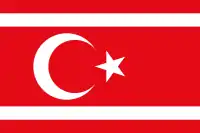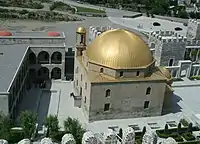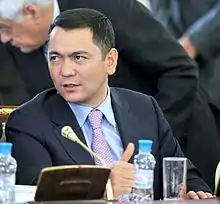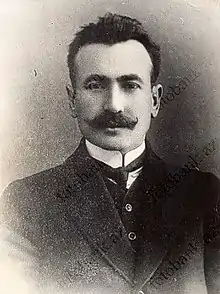Meskhetian Turks
Meskhetian Turks, also referred to as Turkish Meskhetians and Ahiska Turks, (Turkish: Ahıska Türkleri[10][11] Georgian: მესხეთის თურქები Meskhetis t'urk'ebi) are an ethnic subgroup of Turks formerly inhabiting the Meskheti region of Georgia, along the border with Turkey. The Turkish presence in Meskheti began with the Turkish military expedition of 1578,[12] although Turkic tribes had settled in the region as early as the eleventh and twelfth centuries.[12]
 Cultural flag used by Meskhetian Turks | |
| Total population | |
|---|---|
| est. 400,000 to 600,000[1][2] [3][4][5] | |
| Regions with significant populations | |
| 1,500[6][7] | |
| 150,000-180,000[6][7] | |
| 90,000–110,000[6][7] | |
| 70,000–95,000[7][6] | |
| 42,000-50,000[6][7] | |
| 40,000-76,000[8][6] | |
| 15,000-38,000[8][6] | |
| 8,000-10,000[6][8] | |
| 9,000-16,000[8][6] | |
| 180[6] | |
| Languages | |
| Meskhetian Turkish Azerbaijani · Russian · Georgian · Kazakh | |
| Religion | |
| Islam[9] | |
| Related ethnic groups | |
| Abkhazian Turks | |
Today, the Meskhetian Turks are widely dispersed throughout the former Soviet Union (as well as in Turkey and the United States) due to forced deportations during World War II. At the time, the Soviet Union was preparing to launch a pressure campaign against Turkey and Joseph Stalin wanted to clear the strategic Turkish population in Meskheti who were likely to be hostile to Soviet intentions.[13] In 1944, the Meskhetian Turks were accused of smuggling, banditry and espionage in collaboration with their kin across the Turkish border. Expelled by Joseph Stalin from Georgia in 1944, they faced discrimination and human rights abuses before and after deportation.[14] Approximately 115,000 Meskhetian Turks were deported to Central Asia and subsequently only a few hundred have been able to return to Georgia. Those who migrated to Ukraine in 1990 settled in shanty towns, inhabited by seasonal workers.[14]
Origins and terms

Most Meskhetian Turks identify themselves as having descended from Ottoman settlers.[15] Pro-Georgian historiography has traditionally argued that the Meskhetian Turks, who speak the Kars dialect of the Turkish language and belong to the Hanafi school of Sunni Islam, are simply Turkified Meskhetians (an ethnographic subgroup of Georgians) converted to Islam in the period between the sixteenth century and 1829, when the region of Samtskhe-Javakheti (Historical Meskheti) was under the rule of the Ottoman Empire.[16] However, the Russian anthropologist and historian Professor Anatoly Michailovich Khazanov has argued against the pro-Georgian narrative and has said that:
it is quite possible that the adherents of this [pro-Georgian] view oversimplified the ethnic history of the group, particularly if one compares it with another Muslim Georgian group, the Adzhar, who in spite of their conversion to Islam have retained, not only the Georgian language, but to some extent also the Georgian traditional culture and self-identification. Contrary to this, the traditional culture of Meskhetian Turks, though it contained some Georgian elements, was similar to the Turkish one.[16]
Anthropologist Kathryn Tomlinson has pointed out that in Soviet documents about the 1944 deportations of the Meskhetian Turks, the community were referred to simply as "Turks" and that it was after their second deportation from Uzbekistan that the term "Meskhetian Turks" was invented.[17] According to Ronald Wixman, the term "Meskhetian" only came into use in the late 1950s.[18] Indeed, the majority of the Meskhetian Turks call themselves simply as "Turks" or "Ahiskan Turks" (Turkish: Ahıska Türkleri) referring to the region, meaning "Turks of Ahiska Region". The Meskhetians claim sometimes that the medieval Cumans-Kipchaks of Georgia (Kipchaks in Georgia) may have been one of their possible ancestors.[19]
History


Ottoman conquest
By the Peace of Amasya (1555), Meskheti was divided into two, with the Safavids keeping the eastern part and the Ottomans gaining the western part.[20] In 1578, the Ottomans attacked the Safavid possessions in Georgia, which initiated the Ottoman-Safavid War of 1578-1590, and by 1582 the Ottomans were in possession of the eastern (Safavid) part of Meskheti.[21] The Safavids regained control over the eastern part of Meskheti in the early 17th century.[21] However, by the Treaty of Zuhab (1639), all of Meskheti fell under Ottoman control, and it brought an end to Iranian attempts to retake the region.[22][21]
1944 deportation from Georgia to Central Asia

On 15 November 1944, the then General Secretary of CPSU, Joseph Stalin, ordered the deportation of over 115,000 Meskhetian Turks from their homeland,[23] who were secretly driven from their homes and herded onto rail cars.[24] As many as 30,000 to 50,000 deportees died of hunger, thirst and cold and as a direct result of the deportations and the deprivations suffered in exile.[25][24] The Soviet guards dumped the Meskhetian Turks at rail sidings across a vast region, often without food, water, or shelter.
According to the 1989 Soviet Census, 106,000 Meskhetian Turks lived in Uzbekistan, 50,000 in Kazakhstan, and 21,000 in Kyrgyzstan.[23] As opposed to the other nationalities who had been deported during World War II, no reason was given for the deportation of the Meskhetian Turks, which remained secret until 1968.[13] It was only in 1968 that the Soviet government finally recognised that the Meskhetian Turks had been deported. The reason for the deportation of the Meskhetian Turks was because in 1944 the Soviet Union was preparing to launch a pressure campaign against Turkey.[13] In June 1945 Vyacheslav Molotov, who was then Minister of Foreign Affairs, presented a demand to the Turkish Ambassador in Moscow for the surrender of three Anatolia provinces (Kars, Ardahan and Artvin).[13] As Moscow was also preparing to support Armenian claims to several other Anatolian provinces, war against Turkey seemed possible, and Joseph Stalin wanted to clear the strategic Georgian-Turkish border where the Meskhetian Turks were settled and who were likely to be hostile to such Soviet intentions.[13]
Unlike the other deported Muslim groups, the Meskhetians have not been rehabilitated nor permitted to return to their homeland. In April 1970, the leaders of the Turkish Meskhetian national movement applied to the Turkish Embassy in Moscow for permission to emigrate to Turkey as Turkish citizens if the Soviet government persisted its refusal to allow them to resettle in Meskheti. However, the response of the Soviet government was to arrest the Meskhetian leaders.[26]
1989 deportation from Uzbekistan to other Soviet countries
In 1989, riots broke out between the Meskhetian Turks who had settled in Uzbekistan and the native Uzbeks.[23] Nationalist resentments against the Meskhetians who had competed with Uzbeks for resources in the overpopulated Fergana valley boiled over. Hundreds of Meskhetian Turks were killed or injured, nearly 1,000 properties were destroyed and thousands of Meskhetian Turks fled into exile.[23] The majority of Meskhetian Turks, about 70,000, went to Azerbaijan, whilst the remainder went to various regions of Russia (especially Krasnodar Krai), Kazakhstan, Kyrgyzstan[23][27] and Ukraine.
War in Donbass
Around 2,000 Meskhetian Turks have been forced to flee from their homes in Ukraine since May 2014 amid fighting between government forces and pro-Russian separatists. Turkish Meskhetian community representative in the eastern city of Donetsk, Nebican Basatov, said that those who have fled have sought refuge in Russia, Azerbaijan, Turkey and different parts of Ukraine.[14] Over 300 Meskhetian Turks from the Turkish-speaking minority in eastern Ukraine have arrived in eastern Turkey’s Erzincan province where they will live under the country's recently adopted asylum measures.[28]
Demographics
.jpg.webp)
According to the 1989 Soviet Census, there were 207,502 Turks living in the Soviet Union.[1] However, Soviet authorities recorded many Meskhetian Turks as belonging to other nationalities such as "Azeri", "Kazakh", "Kyrgyz", and "Uzbek".[1] Hence, official censuses do not necessarily show a true reflection of the real population of the Meskhetian Turks; for example, according to the 2009 Azerbaijani census, there were 38,000 Turks living in the country; however, no distinction is made in the census between Meskhetian Turks and Turks from Turkey who have become Azerbaijani citizens, as both groups are classified in the official census as "Turks" or "Azerbaijani".[29] According to the United Nations High Commissioner for Refugees report published in 1999, that 100,000 Meskhetian Turks lived in Azerbaijan and the defunct Baku Institute of Peace and Democracy stated, in 2001, that between 90,000 and 110,000 Meskhetian Turks lived in Azerbaijan,[30][31] similarly, academic estimates have also suggested that the Turkish Meskhetian community of Azerbaijan numbers 90,000 to 110,000.[30]
More recently, some Meskhetian Turks in Russia, especially those in Krasnodar, have faced hostility from the local population. The Krasnodar Meskhetian Turks have suffered significant human rights violations, including the deprivation of their citizenship. They are deprived of civil, political and social rights and are prohibited from owning property and employment.[32] Thus, since 2004, many Turks have left the Krasnodar region for the United States as refugees. A large number of them, comprising nearly 1300 individuals, is in Dayton, Ohio. They are still barred from full repatriation to Georgia.[33] However, in Georgia, racism against Meskheti Turks is still prevalent due to differences in beliefs and ethnic tensions.[34]
Culture

Language
The Meskhetian Turks speak an Eastern Anatolian dialect of Turkish, which hails from the regions of Kars, Ardahan, and Artvin.[36] The Turkish Meskhetian dialect has also borrowed from other languages (including Azerbaijani, Georgian, Kazakh, Kyrgyz, Russian, and Uzbek) which the Meskhetian Turks have been in contact with during the Russian and Soviet rule.[36]
Wedding

Meskhetian Turks' weddings consist of a traditional proposal from the groom’s parents and if the bride’s parents accept the proposal, an engagement party, or Nişan, is done. Everyone at the Nişan is given a ceremonial sweet drink, called Sharbat. The actual wedding lasts for two days. On the first day the bride leaves her house and on the second day is when the marriage happens. Before the bride enters her husband's house she uses the heel on her shoe to break two plates with her foot and applies honey on the doorway. This tradition serves the purpose of wishing happiness upon the new bride and groom in their marriage. At the end of the wedding, a dance ensues with the men and women dancing separately. Finally, the newlyweds have their last dance which is called the ‘Waltz’ and that completes the wedding.[37]
Notable people




The following is list of people of Meshetian-Turkish origin:
- Sima Ağayeva, Azerbaijani artist
- Fatih Ahıskalı, Turkish musician[38]
- Taner Akçam, Turkish historian[39]
- Celal Al, Turkish actor in Diriliş: Ertuğrul and Kuruluş: Osman[40]
- Mikael Askarov, Kazakh football player
- Osman Server Atabek, Turkish politician[41]
- Aslan Atem, Turkish wrestler[42]
- Tevfik Arif, Kazakh-Turkish billionaire, real estate developer and investor residing in the US[43][44]
- Refik Arif, Kazakh businessman
- Ali Fuat Azgur, Turkish poet[45]
- Isgender Aznaurov, Uzbek-born National Hero of Azerbaijan who fought in the First Nagorno-Karabakh War[46][47][48]
- Ömürbek Babanov, Kyrgyz billionaire and politician who served as Prime Minister of Kyrgyzstan (2011-2012)[49]
- Yusuf Rıza Bey, Ottoman soldier in the Teşkilât-ı Mahsusa special forces
- Ali Sami Boyar, Turkish painter and museologist
- Erdoğan Çakıcı, Turkish actor[50]
- Adil Efendiyev, Azerbaijani literary critic[51][52]
- Ata Demirer, Turkish filmmaker and comedian[53][54]
- Şefika Şeyhzade-Efendizade, one of the first female journalists, educators, writers and philanthropists in Azerbaijan[55][56][52]
- Muharrem Ergin, Turkish linguist and Turkologist[57]
- Cabbar Faiqov, Azerbaijani military doctor
- Aşıq Feydayi, Azerbaijani ashik
- Abdurrahman Gulahmadov, Azerbaijani scientist
- Khalis Gulahmadov, Azerbaijani scientist
- Asif Hacılı, Azerbaijani literary critic
- Ahıskalı Ali Haydar, lawyer and mystic
- Ziyaeddin İsmihanoğlu, Kazakh businessman and President of the World Association of Meskhetian Turks
- Takhir Kapadze, Uzbek football coach
- Timur Kapadze, Uzbek football player[58]
- Handan Musaoğlu Kasa, Turkish presenter on TBMM TV[59]
- Mediha Kayra, Ottoman-Turkish writer and teacher[60]
- Mukhtar Mukhtarov, Kazakh football player
- Bahram Muzaffer, Uzbek boxer[61]
- Ömer Faik Nemanzade, Azerbaijani journalist[62][52]
- Fatih Osmanlı, Kazakh-born actor in the Turkish historical drama Kuruluş: Osman[63]
- Buğra Öner, Turkish professional boxer[64]
- Alptuğ Öner, Turkish professional boxer[65]
- Cüneyt Özdemir, Turkish journalist[66]
- Silahdar İbrahim Paşa, Ottoman statesman
- Ahmed bey Pepinov, Azerbaijani Minister of Agriculture[67][52]
- Mikail Suleymanov, Uzbek actor, copywriter and film director[68]
- Ravil Tagir, Kazakh-born Turkish football player[69]
- Fırat Tanış, Turkish actor[70]
- Yalçın Topçu, Turkish politician and former Ministry of Culture and Tourism[71]
- Ali Paşa Veyseloğlu, poet
See also
Notes
- Aydıngün et al. 2006, 1.
- Seferov & Akış 2011, 393.
- Today's Zaman (15 August 2011). "Historic Meskhetian Turk documents destroyed". Today's Zaman. Retrieved 21 February 2012.
- Kanbolat, Hasan (7 April 2009). "Return of Meskhetian Turks to Georgia delayed". Today's Zaman. Archived from the original on 25 January 2011. Retrieved 21 February 2012.
- Assembly of Turkish American Associations (5 February 2008). "ATAA and ATA-SC Visit Ahiska Turks in Los Angeles". Today's Zaman. Archived from the original on 12 December 2010. Retrieved 21 February 2012.
- Al Jazeera (2014). "Ahıska Türklerinin 70 yıllık sürgünü". Al Jazeera. Retrieved 2016-07-05.
- Aydıngün et al. 2006, 13.
- Aydıngün et al. 2006, 14.
- Aydıngün et al. 2006, 15.
- page78.
- ahiskalilar.org (turkish)
- Aydıngün et al. 2006, 4.
- Bennigsen & Broxup 1983, 30.
- "Clashes force 2,000 Meskhetian Turks to flee Ukraine - World Bulletin". World Bulletin. Retrieved 2016-02-03.
- Helmut Glück: Metzler Lexikon Sprache, 2005, p. 774
- Khazanov 1995, 195.
- Tomlinson 2005, 111.
- Wixman 1984, 134.
- Yunusov, Arif. The Akhiska (Meskhetian Turks): Twice Deported People. "Central Asia and Caucasus" (Lulea, Sweden), 1999 # 1(2), p. 162-165.
- Mikaberidze 2015, p. xxxi.
- Floor 2001, p. 85.
- Tomlinson 2005, 110.
- UNHCR 1999b, 20.
- Minahan 2002, 1240.
- Polian 2004, 155.
- Bennigsen & Broxup 1983, 31.
- UNHCR 1999b, 21.
- "Turkey welcomes Meskhetian Turks from east Ukraine - World Bulletin". World Bulletin. Retrieved 2016-02-03.
- The State Statistical Committee of the Republic of Azerbaijan. "Population by ethnic groups". Archived from the original on 2012-11-30. Retrieved 2012-01-16.
- UNHCR 1999a, 14.
- NATO Parliamentary Assembly. "Minorities in the South Caucasus: Factor of Instability?". Archived from the original on 2012-03-08. Retrieved 2012-01-16.
- Barton, Heffernan & Armstrong 2002, 9.
- Coşkun 2009, 5.
- "Meskhetian Turks - Minority Rights Group". Minority Rights Group. Retrieved 2017-07-25.
- An Ethnohistorical Dictionary of the Russian and Soviet Empires.
- Aydıngün et al. 2006, 23.
- Ranard, Donald, ed. (2006). Meskhetian Turks: An Introduction to their History, Culture and Resettlement Experiences. Washington, DC: the Center for Applied Linguistics. pp. 18–19.
- Fatih AHISKALI ile Röportaj, Ahiska Press, 2010, retrieved 20 December 2020,
O an çok gururlandım Ahıskalı olduğum için.
- Taner Akçam'la "soykırım" üzerine, Bizim Anadolu, 2010, retrieved 21 December 2020,
(Gülerek) Herkes etnik kökenine bakıyor. Vallahi ben çok safkan bir Türküm. Ahıska Türkleri derler bize Kars'ta. Ve, bizim sülalemizden birilerinin Ermeni çeteleri tarafından öldürülmüş olabileceği ihtimali de oldukça kuvvetli. Ama bu tür şeyler benim için hiç önemli değil. Ben sonuçta bir akademisyenim ve bilim adamı olarak konuyu araştırıyorum.
- DATÜB Gençlik Kolları, Ahıskalı oyuncularla bir araya geldi, DATÜB Gençlik Kolları, 2020, retrieved 21 December 2020,
Ahıska Türkü oyuncular Celal Al ve Ladibek Fatih Osmanlı, Kazakistan’dan gelen Ahıskalı Muhammed Mustafayev, Mevlüt Karimov ve DATÜB Gençlik Kolları Yönetim Kurulu Üyesi İskender Ziyaoğlu ile bir araya geldi.
- Zeynep Atabekoğlu ile Babası Osman Server Atabek Üzerine Konuşma (PDF), Bizim Ahıska, 2011, retrieved 21 December 2020,
Canımdan çok sevdiğim, hiçbir zaman unutamadığım rahmetli babam Osman Server Atabek, 20 Ağustos 1886’da Ahıska’da dünyaya gelmiştir.
- Ahıska Türkü: Aslan Atem dünya ikincisi, Ajans Ahıska, 2016, retrieved 21 December 2020,
Dünya Grekoromen Güreş Şampiyonası'nda 80 kiloda mücadele eden milli sporcu ahıska Türkü Aslan Atem, finalde Rus güreşçi Ramazan Abacharaev'e 3-1 yenilerek dünya 2'incisi olarak gümüş madalya kazandı.
- Gözaltındaki milyarder işadamı, Radikal, 2010, retrieved 22 December 2020,
milyarderi Kazak kökenli işadamı Tevfik Arif’in ailesi Ahıska Türklerinden. Tevfik Arif,...
- Ne şanslı adam diyorlar ya..., Sabah, 2009, retrieved 20 December 2020,
Tevfik Arif Bey Ahıska Türkü. Doğma büyüme Kazakistanlı. ABD'de yaşıyor.
- Fuat Azgur’la Mülakat, Bizim Ahıska, 2011, retrieved 21 December 2020,
Ailemiz Posof’a 1921 yılında gelmiş. Öyle anlaşılıyor ki, 16 Mart 1921 tarihinde imzalanan Moskova Antlaşması’yla Ahıska’nın ötede kalması kesinleşince, ailemiz Türkiye’ye göç etmiş ve Posof’a yerleşmiş.
- Kassanov’dan Ahıskalı Türklerin Milli Kahramanı İskender Aznaurov’un Annesine Ziyaret, Dünya Ahıska Türkleri Birliği, retrieved 21 December 2020
- Şehit Aznaurov’un annesi Türkiye’ye getirildi, Ekovitrin Haber, 2020, retrieved 21 December 2020,
Ahıska Türklerinin milli kahramanı Şehit İskender Aznaurov’un Moskova’da yaşayan 84 yaşındaki annesi Kamile Mustafayeva, Dünya Ahıska Türkleri Birliği’nin (DATÜB) girişimleri ile Türkiye’ye getirildi.
- Ahıskalı Türkler Savaşa Hazırdır, Ahıska Gençlik, 2020, retrieved 21 December 2020,
Onlardan biri de Azerbaycan’ Milli Kahramanı Ahıskalı Türk İskender Aznaurov’dur (Topçu İskender)
- Kırgızistan'da cumhurbaşkanlığı seçim yarışında iki eski başbakan öne çıkıyor, Anadolu Agency, 2017, retrieved 20 December 2020,
Babanov'un annesinin Kırgız olmamasını zaman zaman siyasi malzeme olarak kullanıyor. Babanov da durumu "Rahmetli annem, İkinci Dünya Savaşı döneminde Gürcistan'ın Batum şehrinden Kırgızistan'a sürüldü. Uzun tren yolculuğu sırasında anne ve babasını kaybeden küçük kıza bir Kırgız ailesi sahip çıktı. Ben Kırgız ailesinde büyüdüm. Annem Ahıska Türkü'dür babam da Kırgız" sözleriyle açıklıyor.
- FATMA GİRİK VE TÜRKAN ŞORAY’I SİNEMAMIZA KAZANDIRAN AHISKA KÖKENLİ Erdoğan Çakıcı, Ajans Ahiska, 2015, retrieved 20 December 2020
- Gasimov, Zaur (2017), Historical Dictionary of Azerbaijan, Rowman & Littlefield, p. 86, ISBN 1538110423,
Efendiyev, Adil (1907-1973). Azerbaijani poet, translator, and intellectual Efendiyev was born into a family of Ahiska Turkish teachers.
- Meşedihasanlı, Ramiz (2010), BUGÜN, Ahıska Press, retrieved 21 December 2020,
Bunlar; Ömer Faik Nemanzade, Osman Server Atabek, Hafız Efendi, Şefika Hanım Efendi Zade, Prof. Cerrah Fuat Efendiyev, Adil Efendiyev, Ahmet Bey Pepinov, Enver Odabaşev (Odabaş), Yusuf Serverov, (Serveroğlu), Cevat Koçiyev, Saadat Gülahmedova ve saymakla sonu gelmeyen nice şahıslarımız olmuştur.
- “Ben bunu yemeeem” diyen kadın beni yorar- Kadın yemekten zevk almazsa suçluluk hissederim, Milliyet, 2010, retrieved 21 December 2020,
Benim annem güzel mantı yapar. Ahıska Türklerinden bizim sülale. Bizim oraların mantısına hingel denir.
- Roman değilim olsam gururla söylerdim, Hürriyet, 2011, retrieved 21 December 2020,
Roman değilim, olsam gururla söylerdim. Annem Ahıska Türkleri’nden, babam ise Arnavut...
- Agezova, Sevilya (2019), Sürgün Öncesinde Ahıska Türkleri İçerisinde Eğitim Anlayışı: Şefika Şeyhzade-Efendizade ve Fürget Hocazade Örneğinde (PDF), ULUSAM
- Memmedli, Şureddin (2012), ŞEFİKA ŞEYHZADE-EFENDİZADE (PDF), Bizim Ahıska, p. 13,
Bizim Ahıska’mızın okuyucularıyla paylaştığımız Ahıskalı kadın aydınımız Şefika Şeyhzade-Efendizade’dir. Övüncümüzün kaynağı, onun birkaç yönden ilk ve öncü olmasıdır. Azerbaycan ve genellikle Türk dünyası eğitim, kültür, edebiyat tarihinde önemli yer tutan Şefika Şeyhzade-Efendizade, ilk kadın öğretmen, ilk kadın eğitimci-pedagog, ilk kadın gazeteci, ilk kadın yazar olmak gibi şeref payelerine sahiptir
- Gasimov, Zaur (2019), ""The Turkish Wall": Turkey as an Anti-communist and Anti-Russian Bulwark in the Twentieth Century", Rampart Nations: Bulwark Myths of East European Multiconfessional Societies in the Age of Nationalism, Berghahn Books, ISBN 1789201489,
At that time, Muharrem Ergin (1923-1995) was one of the leading Turkish philologists and an expert in ancient Turkish literature. Ergin was the descendant of an emigrant family from the Ahiska region of Georgia and studied philology at Istanbul University under the exiled Azerbaijani professor Ahmet Caferoğlu
- Meşedihasanlı, Ramiz (2013), Ahıskalı Türkü Kazakistan’da En İyi Futbolcu Seçildi, Ahıska Press, retrieved 21 December 2020,
Kazakistan’ın Aktobe takımında top koşturan Özbekistan vatandaşı Ahıskalı Türkü Timur Kapadze, Haziran ayının en iyi futbolcusu seçildi.
- Handan Musaoğlu Kasa ile medya ve spikerlik üzerine, Ajans Ahiska, 2018, retrieved 20 December 2020
- Herzog, Christoph (2014), "The Urban Experience in Women's Memoirs: Mediha Kayra's World War I Notebook", Women and the City, Women in the City: A Gendered Perspective on Ottoman Urban History, Berghahn Books, p. 154, ISBN 178238412X,
Mediha Kayra was born in 1902 in Trabzon and died 2003 in Kadıköy, Istanbul, when she was 101 years old. Her father was the merchant (tüccar) Ali Lütfi Dihkanzade (1869–1931). His family originated from Azerbaijan. Her mother, Kadriye Salihoğlu, originated from Akhaltsikhe (türk. Ahıska) in southwest Georgia. The families had emigrated to Trabzon following the wars with Russia in 1878 and 1828.
- Ahıska'lı Bahram Muzaffer 1.Avrupa Oyunları'nda 2.Turda, Ajans Ahiska, 2015, retrieved 21 December 2020
- Piriyeva 2005, 6.
- Fatih AHISKALI ile Röportaj, Güneydoğu Güncel Haber Gazetesi, 2020, retrieved 21 December 2020,
Fatih Osmanlı; 11 Eylül 1979 Almatı Kazakistan doğumlu aslen Ahıska Türkü'dür. 2017 yılında Vatanı Türkiye’ye yerleşip temel oyunculuk dersleri alıp hayal ettiği oyunculuk kariyerine başladı. Kuruluş dizisinde başarılı oyunculuk performansı ile dikkatleri çekmeyi başardı.
- Boxing becomes a bridge between Ahiska Turks, Americans in Ohio’s Dayton, Daily Sabah, 2016, retrieved 20 December 2020
- Buğra Öner ve Altuğ Öner'e silahlı saldırı düzenlenen an, TGRT Haber, 2016, retrieved 21 December 2020,
Anne tarafı selanik muhaciri, Babası Ahıska Türk'üdür.
- Başörtülü annenin evlâdı, Sabah, 2010, retrieved 20 December 2020,
Ah benim öz be öz Ahıska Türkü annem.
- Piriyeva, Sevil (2005), Ahıska Türkləri Azərbaycanda tarixi sosial medeni heyati, Elm, p. 60, ISBN 5806616841 Check
|isbn=value: checksum (help) - Aliyev, Nezir (2018), Dünyanın ilk ve tek Ahıska tiyatro ekibi 20 yıldır sahnede, Anadolu Agency, retrieved 21 December 2020
- Altınordu'nun genç yıldızı Avrupa devlerini peşine taktı, Milli Gazete, 2020, retrieved 20 December 2020,
1944'te Sovyetler Birliği döneminde Kazakistan'a sürgüne gönderilen Ahıska Türkleri'nden olan Tagir ailesinin kaderi, Ravil'in teyzesi Maygül Hanım'ın evlenip Bursa'ya yerleşmesiyle değişiyor.
- Fırat Tanış Kimdir?, Sabah, 2016, retrieved 20 December 2020,
Fırat Tanış, 5 Mayıs 1975 tarihinde İstanbul, Kadıköy'de doğmuştur. Tam adı Nuri Fırat Tanış'dır. Gürcistan; Ahıska kökenli ve annesi babası terzi olan Fırat Tanış ailenin en küçük çocuğudur.
- Kazakistan Cumhurbaşkanı Nazarbayev’den Yalçın Topçu’ya Madalya, Haber7, 2019, retrieved 20 December 2020,
esepsiyonda konuşan Topçu minnettarlıklarını belirterek “ben bir Ahıska Türk’ü ailenin çocuğuyum. Yıllar önce akrabalarımı bağırlarına bastıkları için Kazakistan halkına minnettarım.
Bibliography
- Aydıngün, Ayşegül; Harding, Çiğdem Balım; Hoover, Matthew; Kuznetsov, Igor; Swerdlow, Steve (2006), Meskhetian Turks: An Introduction to their History, Culture, and Resettelment Experiences (PDF), Cultural Orientation Resource (COR) Center
- Barton, Frederick D.; Heffernan, John; Armstrong, Andrea (2002), Being Recognised as Citizens (PDF), http://www.humansecurity-chs.org/: Commission on Human Security, archived from the original (PDF) on 2011-07-17
- Bennigsen, Alexandre; Broxup, Marie (1983), The Islamic threat to the Soviet State, Taylor & Francis, ISBN 0-7099-0619-6.
- Blacklock, Denika (2005), Finding Durable Solutions for the Meskhetians (PDF), European Centre for Minority Issues, archived from the original (PDF) on 2010-06-02
- Coşkun, Ufuk (2009), Ahiska/Meskhetian Turks in Tucson: An Examination of Ethnic Identity (PDF), University of Arizona, archived from the original (PDF) on 2012-01-11
- Cornell, Svante E. (2001), Small Nations and Great Powers: A Study of Ethnopolitical Conflict in the Caucasus, Routledge, ISBN 0-7007-1162-7.
- Council of Europe (2006), Documents: working papers, 2005 ordinary session (second part), 25–29 April 2005, Vol. 3: Documents 10407, 10449-10533, Council of Europe, ISBN 92-871-5754-5.
- Drobizheva, Leokadia; Gottemoeller, Rose; Kelleher, Catherine McArdle (1998), Ethnic Conflict in the Post-Soviet World: Case Studies and Analysis, M.E. Sharpe, ISBN 1-56324-741-0.
- Elbaqidze, Marina (2005), "Multiculturalism in Georgia: Unclaimed Asset or Threat to the State?", in Czyzewski, Krzystof; Kulas, Joanna; Golubiewski, Mikolaj (eds.), A Handbook of Dialogue: Trust and Identity.
- Enwall, Joakim (2010), "Turkish texts in Georgian script: Sociolinguistic and ethno-linguistic aspects", in Boeschoten, Hendrik; Rentzsch, Julian (eds.), Turcology in Mainz, Otto Harrassowitz Verlag, ISBN 978-3-447-06113-1.
- Floor, Willem (2001). Safavid Government Institutions. Costa Mesa, California: Mazda Publishers. ISBN 978-1568591353.
- Khazanov, Anatoly Michailovich (1995), "People with Nowhere To Go: The Plight of the Meskhetian Turks", After the USSR: Ethnicity, Nationalism and Politics in the Commonwealth of Independent States, University of Wisconsin Press, ISBN 0-299-14894-7.
- Kurbanov, Rafik Osman-Ogly; Kurbanov, Erjan Rafik-Ogly (1995), "Religion and Politics in the Caucasus", in Bourdeaux, Michael (ed.), The Politics of Religion in Russia and the New States of Eurasia, M.E. Sharpe, ISBN 1-56324-357-1.
- Mikaberidze, Alexander (2015). Historical Dictionary of Georgia (2 ed.). Rowman & Littlefield. ISBN 978-1442241466.
- Minahan, James (2002), Encyclopedia of the Stateless Nations: L-R, Greenwood Publishing Group, ISBN 0-313-32111-6.
- Pepinov, Fuad (2008), "The Role of Political Caricature in the ultural Development of the Meskhetian (Ahiska) Turks", in Kellner-Heinkele, Barbara; Gierlichs, Joachim; Heuer, Brigitte (eds.), Islamic Art and Architecture in the European Periphery: Crimea, Caucasus, and the Volga-Ural Region, Otto Harrassowitz Verlag, ISBN 978-3-447-05753-0
- Polian, Pavel (2004), Against Their will: The History and Geography of Forced Migrations in the USSR, Central European University Press, ISBN 963-9241-68-7.
- Rasuly-Paleczek, Gabriele; Katschnig, Julia (2005), Central Asia on Display: Proceedings of the VIIth Conference of the European Society for Central Asian Studies, LIT Verlag Münster, ISBN 3-8258-8309-4.
- Rywkin, Michael (1994), Moscow's Lost Empire, M.E. Sharpe, ISBN 1-56324-237-0.
- Seferov, Rehman; Akış, Ayhan (2011), Sovyet Döneminden Günümüze Ahıska Türklerinin Yasadıkları Cografyaya Göçlerle Birlikte Genel Bir Bakıs (PDF), Türkiyat Araştırmaları Dergisi, archived from the original (PDF) on 2013-09-27, retrieved 2012-03-02
- Tomlinson, Kathryn (2005), "Living Yesterday in Today and Tomorrow: Meskhetian Turks in Southern Russia", in Crossley, James G.; Karner, Christian (eds.), Writing History, Constructing Religion, Ashgate Publishing, ISBN 0-7546-5183-5.
- UNHCR (1999a), Background Paper on Refugees and Asylum Seekers from Azerbaijan, United Nations High Commissioner for Refugees
- UNHCR (1999b), Background Paper on Refugees and Asylum Seekers from Georgia, United Nations High Commissioner for Refugees
- Wixman, Ronald (1984), The Peoples of the USSR: An Ethnographic Handbook, M.E. Sharpe, ISBN 0-87332-506-0.
References
- Robert Conquest, The Nation Killers: The Soviet Deportation of Nationalities (London: Macmillan, 1970) (ISBN 0-333-10575-3)
- S. Enders Wimbush and Ronald Wixman, "The Meskhetian Turks: A New Voice in Central Asia," Canadian Slavonic Papers 27, Nos. 2 and 3 (Summer and Fall, 1975): 320-340
- Alexander Nekrich, The Punished Peoples: The Deportation and Fate of Soviet Minorities at the End of the Second World War (New York: W. W. Norton, 1978) (ISBN 0-393-00068-0).
- Emma Kh. Panesh and L. B. Ermolov (Translated by Kevin Tuite). Meskhetians. World Culture Encyclopedia. Accessed on September 1, 2007.